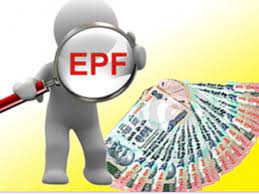The Employees Provident Fund (EPF) is a program that allows for the collection of retirement benefits. Learn how much your company contributes to your EPF by reading this article.
What is the Employees’ Provident Fund?

The Employees’ Provident Funds and Miscellaneous Provisions Act of 1952 establishes EPF as its primary program. The program is run under the direction of the Employees’ Provident Fund Organization. Every institution with 20 or more employees is protected, and some organizations that employ less than 20 individuals are also covered. Both the employee and the employer pay 12 percent of the base income to the EPF plan on a monthly basis. 8.33 percent of the employer’s contribution is allocated to the Employee Pension Scheme.
According to the regulations, an employee is a non-eligible employee if their “pay” at the time of joining exceeds Rs 15,000 per month. Employees who make less than Rs. 15,000 per month are required to join the EPF. However, if both the employee and the employer agree, an employee who is receiving “pay” over the specified maximum (currently Rs 15,000) may join with approval from the Assistant PF Commissioner.
Features of EPF
- There are many programs within the EPF. It is made up of three separate programs, each with a different objective. Where your retirement benefits are accrued is in the first section of the EPF. This is how the program generates profit. Employees’ pension scheme is the second component of EPF. The goal of EPS is to produce pensions for workers once they reach the age of 58. The Employee Deposit Linked Insurance Scheme (EDLI) is a type of life insurance and the third component of the EPF.
- Employee Pension Scheme will get 8.33 percent of the employer’s contribution, although it is based on Rs 15,000 instead.
- The monthly diversion towards EPS is Rs 1,250 for each employee whose base salary is Rs 15,000 or above.
- If the basic wage is less than Rs. 15,000, 8.33% of the total sum will be allocated to EPS. The remaining amount will remain in the EPF program.
- The EPF withdrawal is not taxed when five years of continuous service is achieved.
- It will be considered continuous service if a person has changed jobs in less than five years but transferred their EPF to the new employer.
What are the benefits of Employees’ Provident Fund?
- If there is a financial emergency, a PF account holder may borrow money against their PF balance with an interest rate of only 1%. The loan has to be repaid within 36 months after the loan’s disbursement.
- You may be able to develop a stronger foundation for the future with a small monthly commitment.
- After at least five years of constant service, you can avail tax benefits.
- It develops a saving habit to support you in times of need.
- The linked PF account is a separate account that may be kept open both during and after employment.
- In a medical or financial emergency, EPFO permits a partial withdrawal, subject to terms and conditions.
- In accordance with the EDLI policy, a PF account holder qualifies for free insurance up to Rs 7 lakh in the event of death within the service term. The death benefit was formerly Rs. 6 lakh. The owner of a PF account is not required to pay an insurance premium for the death benefit under the EDLI plan.
Who is eligible for EPF?
Any company with 20 or more employees is required to register with the EPFO and offer EPF benefits to its workers. However, businesses with fewer than 20 employees may voluntarily enroll in the EPF scheme. It is possible to completely opt out of the EPF program. When you join your first firm with a base income of more than Rs. 15,000 per month, you have the option to opt out of the EPF system. Since you have never made a contribution to an EPF system, you can fill out Form 11 when you join the company, and they will classify you as an exempt employee for PF reasons. This program is not for Jammu & Kashmir residents.
What is the EPF interest rate?
- The finance minister approved the Employee’s Provident Fund in October 2021. The EPFO then instructed field staff to begin crediting subscribers’ accounts as soon as the newly announced interest of 8.5 percent for the year 2020–21 became available.
- Only after receiving government approval from the finance ministry may the Employee’s Provident Fund Organization (EPFO) announce interest rates.
- In comparison to the 8.65 percent interest paid in the year 2018–19, provident fund deposits now pay an interest rate of 8.5%, which is the lowest in seven years. In the month of March of the following year, 2020, the rate was first lowered.
How much EPF is deducted from salary?
To contribute to your EPF, you and your employer must send 10% or 12% of your base pay. Female employees are only required to contribute 8% of their base pay for the first three years. Your employer’s EPF contribution will continue to be 12 percent at this time. If an employee earns Rs. 15,000 or more per month or more, the employer’s 12 percent payment is split in half. 15,000 rupees, or 8.33 percent, go to the EPS account. i.e., the sum plus Rs. 1,250 every month. Amounts over Rs. 1,250 are deposited to the EPF account each month.
Leave a Reply